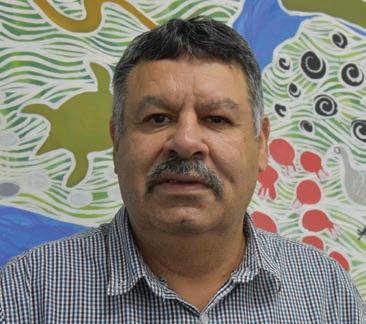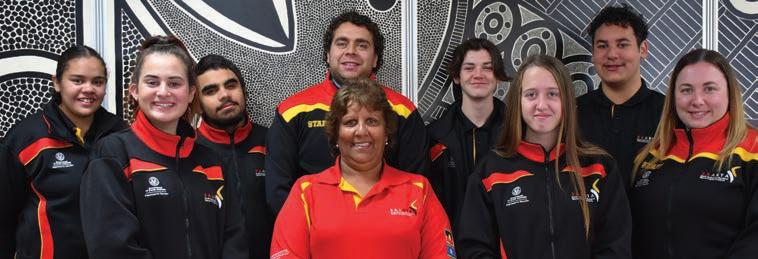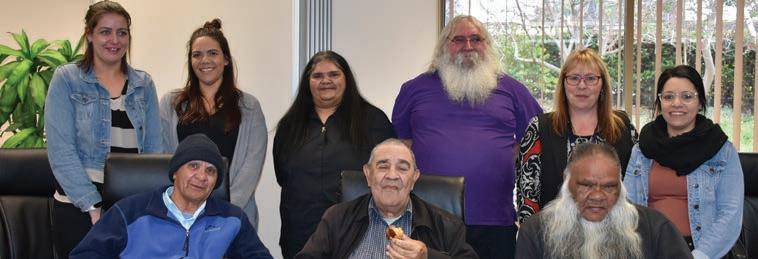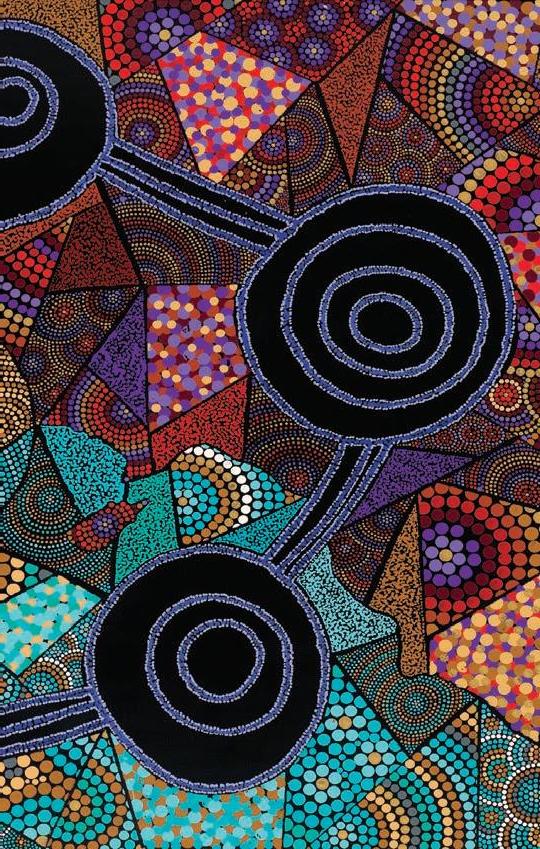
20 minute read
Memories of Growing Up Aboriginal in Australia
A new book that reveals Indigenous people’s memories of growing up was created to help develop understanding between black and white Australia, says Wiradjuri author Anita Heiss.
She is the editor of the book Growing Up Aboriginal in Australia. “What we wanted to do with this book was we wanted readers to understand first-hand from us, in our voices, as First Nations people directly, what our life experiences were, as children, and as teenagers, being socialised, as Aboriginal people, in this country” said Ms Heiss. While the stories are personal, it reflects a wider national experience she said. “I personally believe that how we grow up as a nation is linked to how we grow up as individuals.
Advertisement
“I think that if non-indigenous Australians can understand how we have grown up then they’ll have a better understanding “The biggest thing was the obsession that people wrote about that nonindigenous Australians have about how we look. Our skin colour. And ‘you don’t look Aboriginal’, that sort of obsession” Ms Heiss said.
in review
of who we are today, and perhaps a greater sense of community can be created between black and white Australia” said Ms Heiss.
I didn’t know I was black till I was seven years old. I didn’t know that people would eventually cross the street to avoid walking on the same path as me.
I didn’t know that people would define me as ‘not looking that Aboriginal’ as if it were a compliment. I never foresaw that people would think they understood my story before they heard a word pass through my lips. Zachary Penrith-Puchalski The book holds the stories of a diverse group of Indigenous people from across Australia, ‘from Nukunu to Noongar, Wiradjuri to Western Arrente, Ku Ku Yalinji to Kunbidji, Gunditjamara to Gumbaynggirr and many places in between’ says Ms Heiss in the book’s introduction.
The life stories come from people of a variety of backgrounds; from boarding schools, prison, from schoolchildren, university students and grandparents, opera singers, actors, journalists, academics and activists.
Black bum: these two words mark the first time I realised I was different because my difference was pointed out to me. I was five years old, in my first year of primary school in Canberra and this small barb was thrown at me by another girl in my class. Celeste Liddle
Some are well known figures or published authors, others had never been published before they submitted their childhood memories.
“We’ve got 52 different voices in this anthology, and so it’s not just one person saying this was my experience. “There’s 52 diverse voices from right across the country” said Ms Heiss While there is diversity in the voices and stories, there are many similarities said Ms Heiss.
“Well, the big theme is about identity. “So the Aboriginality and how individuals define that for themselves. But also how identity has been imposed on people.
I once had a friend who said to me, somewhat confused, “If your mum is white and your dad is black, then why aren’t you grey?” I was ten.
I laugh sometimes when I think of that remark, not because it was humorous but because, funnily enough, that’s how my life felt most days. My world was often grey.
Every area was a grey area because of who I was; a grey Aboriginal. Melanie Mununggurr-Williams The issue of ‘looking Aboriginal’ is a recurring theme across the stories Ms Heiss told Aboriginal Way.
Editor of Growing Up Aboriginal in Australia, Anita Heiss. Photo: Amanda James.
I remember lying under our big
Poinciana tree in the backyard and trying to come up with theories about why I was so pale and freckled. I can’t remember many of them now, but one does stand out: that I was white and my dad was black, because I had been born here, in this country. I thought if I had been born in Vanuatu, I would have taken after my father. Amy McQuire The book also holds a lot of discussion about kinship. About the relationships with parents, siblings, grandparents and extended family can connect people to their history, culture and identity. “Connection to family and country, Australian history, I should say, was one of the central themes” Ms Heiss said.
Like my family before me, I grew up on the far north coast of New South Wales, and call the regions of the north and south of the Clarence River – the Bundjalung and Gumbaynggirr nations – home. It is the place where my relatives reside today, and where I visit frequently to walk on country to reaffirm my identity and learn to be a Bundjalung and Gumbaynggirr man, a Koori, an Aboriginal.
Todd Phillips
Racism is an unavoidable reality that is recalled in the lives of almost all contributors.
“I think one of the things that stood out that shocked me was the level of racism in the education system that was flagged in many stories, from primary right through to the tertiary level” said Ms Heiss. “Which made the purpose of this book even more significant because it is firstly directed at a high school audience” she said.
Then it felt as though I’d been found out by my whole school, and I was instantly confronted with an onslaught of questions and reactions that I was in no way prepared for. “Do you believe in the Dreamtime?” “Like, how much Aboriginal are you though? A quarter? A sixteenth?” I was ashamed when I couldn’t come up with the right answers, so very quickly I became obsessed with building myself into a spokesperson of sorts for Aboriginal Australia to my white friends and even whiter school environment. Marlee Silva
The book aims to increase awareness by teachers about Aboriginal cultures and the impact of racism on Indigenous students. Ms Heiss is encouraging teachers to read and consider the personal stories in the book. “I’m really excited then in a couple of weeks’ time I’m going to be speaking at Melbourne University at a teacher professional staff development day. “Every single delegate, the 600 of them, will get a copy of this anthology. And I know that it will impact on their understanding of who we are” she said.
Some of my earliest memories come from the time I spent in a native mission. All I wanted was to hug my big brother – my hero; my world.
I just wanted some comfort from him.
I couldn’t stop the tears that rolled down my face. I was not allowed to talk to him, even though we were in the same mission. I was six years old, for goodness sake, and couldn’t understand why they wouldn’t let me touch him.
Carol Pettersen
While conceived as a learning tool, the book is engaging and readable on its own terms for general readers. “There was no desire for this to be an academic work. We just wanted people to tell your story the way you remember it actually. “While there are some very challenging things, issues, dealt with in the anthology, it has a lot of humour. “I think there’s a lot of warmth in there, and you can read in almost every story a generosity of spirit from the author. “Each and every one of them, I believe, understood that they could help make change by sharing this story. And that’s what this book is really about” said Ms Heiss.
Growing up Aboriginal in Australia is published by Black Inc Books. All quotes above have been taken from that book.
The Narungga Nation has started work on the economic and community development projects made possible by the Buthera agreement which was signed with the state government early this year.
The formal agreement was signed in the final days of the last state government and has been honoured by the current government. It grew out of talks with Aboriginal people statewide about possible treaty with the state government. Narungga man and experienced executive Klynton (Kandy) Wanganeen (pictured right) has been appointed Chief Executive Officer of the Narungga Nation Aboriginal Corporation (NNAC), with Garry Goldsmith taking on the role of Business Manager and Cyril Kartinyeri Project Officer. Now that the Narungga Nations team has been appointed, they want to get to work on “the nitty gritty, which is co-designing and co-delivering on the two streams of the agreement” Mr Wanganeen told Aboriginal Way. “We have the two strategies, one is capacity building, economic participation and economic development including comanagement of Innes National Park. “Then we have the social services stream, we’ll be looking at the juvenile justice strategy, domestic violence and child protection” he said. The team doesn’t want to get started without input from the community and has plans to create an Elders committee among other consultation processes. “One of the vital things that we want to get kicked off with that is establishing a Narungga elders committee. We’ve drafted an expression of interest process and terms of reference for that committee and we’ll be promoting that pretty soon” he said. “We will ensure that our Elders committee get to look over everything that we do and give that cultural advice that we need, to make sure that we don’t run full speed ahead without bringing the community and the elders along with us” said Mr Wanganeen. Liaison with different parts of the state government will also be crucial the new CEO of NNAC says. “Next phase we’ll be meeting with the Commissioner for Public Employment and the Commissioner for Aboriginal Engagement and the Executive Director for Aboriginal Affairs and Reconciliation, to really kickstart the formal process of co-designing how Narungga services will be delivered” he said.
Innes National Park is a protected area at the tip of the Yorke Peninsula, on Narungga traditional country and in an area that is covered by their active native title claim. Discussions have begun to work towards co-management of the park. “In regards to Innes National Park we held a two-day forum down there where we started exploring what we need to do and the timelines for it” Mr Wanganeen said. Fishing and aquaculture businesses are a key to future economic development says Mr Wanganeen. “We’ve already held a workshop at Point Pearce, in terms of the first commercial licence from the fishing component. That’s the turbo shell licence, which our people know as warreners” “We’re pretty close to starting the business for that and then building upon that for a Narungga harvest strategy and negotiating that component, as well as looking at the big ticket item which is abalone” he said. The team is also looking at ways to further acquaculture and tourism business, beginning with a trip to Kangaroo Island, where they looked at a tourism operation and abalone farm. “They run, as part of the tourism business, sightseeing, swimming with seals and dolphins. “Those kinds of activities can easily be done on Yorke Peninsula as well… if they wanted to do something around Wardang Island, they have the capacity to do that, and the experience. “While on Kangaroo island, our team also had a visit to the land-based abalone farm. The company that has that, they have a farm on Tasmania, down in the southeast, and we’re looking at opportunities to get into aquaculture, land-based as well as sea-based” Mr Wanganeen said. While economic development is important, the Narungga nation are also turning their attention to social issues. “We will also be developing the justice strategy and looking at child protection issues for Narungga people. We’ll be exploring options about a safehouse and domestic violence and exploring options for keeping our youth out of detention and our adults out of the detention centres, and looking at ways we can support rehabilitation and lead onto pathways for employment and education. “While we’re doing that, also we’ll be developing a Narungga Health Assembly, because the wellbeing of our community and the health of our community is vital, and we can’t afford to lose people when they’re quite young. In the Buthera agreement, the state government agreed to expedite a consent determination process for the Narungga people. Mr Wanganeen says that process will start in 2019 as far as the community is concerned. “In the mind of government or lawyers they may be working on it earlier. But until we actually sit down as a community to look at consent determination and what it means, it hasn’t really kicked off. “We have to temper the fact that native title is not a panacea pill for the Narungga people” he said. For Mr Wanganeen, supporting Narungga people to live in prosperity on the Yorke Peninsula is key. “How do we create opportunities for Narungga people to actually establish themselves and have home ownership and land parcels on Yorke Peninsula, which is our traditional country, when so much of it has already been stolen and sold off.

“By building an economic base, we can support families to get into small business, family businesses, individual businesses. “Then the aspirations of us is how do we develop our own homeland movement, so that people can be supported by our organisation to really get their footing to create something that’s long-lasting for their children and grandchildren. “The work that we’re doing now, the results of that, won’t be seen for another generation or so. And it’s one of our hopes, is that we build the process whereby Narungga people will be economically independent of all government and won’t rely on anyone else except the Narungga people for their future” Mr Wanganeen said.
Students gain insight into the stolen generations with new project
A new collaborative project will give voice to the stolen generations to teach students about the past.
The project, led by the University of Adelaide, will involve Students from Murray Bridge High School and the Ngarrindjeri community and aims to gather oral histories from members of the stolen generations of that region. The project will provide a platform for members of the stolen generation to tell their stories and share a personal artefact with the students.
The artefacts and stories will eventually be presented as an exhibition and used in the classroom as part of the history curriculum. Cheryl Love, Ngarrindjeri Elder said the community is still greatly affected by the forced removal of children from their families.
“For many of my people, the memory of being removed from family and culture is still real and has had as much


Top: Murray Bridge High School students with Cheryl Love. Bottom: Elders and members of the Ngarrindjeri community. Photo: Lyn Watkins.
of an impact as it did when it started in the last century.” Dr Katie Barclay, Senior Researcher in History from the University of Adelaide, said that teaching students about what happened in their community will help them understand how it still has bearing today. “Despite the impact that the process had on communities, the history of the Stolen Generations is not widely told in South Australian schools, nor are these legacies and their impacts well understood,” says Dr Barclay. “The forcible removal of children has left deep legacies, not only in terms of hurt and loss of family and identity for the members of the community who were removed or who lost their children, but for the wider community and for their children in the present, who live in its shadow” she said.
From the early 1900s to the 1970s, children of Aboriginal and Torres Strait Islander descent were forcibly removed from their families and assimilated into white Australian families and institutions. Estimates of the number of children removed vary from tens of thousands to more than 100,000. The project, titled, Rawul-Inyeri, is from Ngarrindjeri words meaning “belonging to time past”.
Native title in South Australia continued to move forward over the last financial year, with developments in the approach by the Federal Court to finalising matters and the impact of the pending Timber Creek compensation case having an impact on native title outcomes in the state.
In the recently published Annual Report for 2017/2018, Chief Executive Officer Keith Thomas said that he is pleased with the achievements of SA Native Title Services (SANTS) over the year.
“We continue to enjoy considerable success with four consent determinations this year; three native title applications and one compensation application. The pinnacle was the consent determination for the Kaurna people which covers Adelaide and surrounding areas; the first such determination over a capital city.
“SANTS continues to provide and assistance to native title claimants and holders. Significant support has been provided to PBCs as they strive to achieve their aspirations with a focus on capacity development and good governance. SANTS has also partnered with groups to assist in managing projects and has provided other services on a fee for service basis” he said.
SANTS also continues to continually improve its own corporate affairs with strong governance and a relatively stable workforce.
“I take this opportunity to thank the Board for their direction and advice and my management team and staff for their continued effort to deliver best practice services and outcomes for Aboriginal people in South Australia” said Mr Thomas.
Mr Thomas pointed out that there have been significant issues and developments relating to Federal Court processes over the past year.
“With the changes to the Federal Court in South Australia a significant development has been the listing of matters for trial even where successful negotiations are taking place. This has a significant impact upon
SANTS particularly the stress this places upon our limited resources including funds and people.”
The matter of the Timber Creek compensation case is having an impact in
South Australia as it is across the nation, Mr
Thomas said. “The question of compensations is still having a significant impact with groups reluctant to negotiate Settlement ILUAs with the State while waiting for the outcome of the Timber Creek matter in the High Court.
Each year SANTS produces an operational plan that sets out milestones the organisation strives to achieve.
“SANTS’ performance results were outstanding this year. We had strong results in achieving our milestones in our operational plan with about twenty groups receiving assistance to further their native title matters.
“SANTS financial results were also positive, with less than one per cent of our core funding unspent at the end of the year. However, SANTS continues to suffer with the static nature of our funding not allowing for growth. Nevertheless, I am well pleased that we were able to make significant progress with many of our matters this year.”
Looking forward to the current financial year, Mr Thomas said that the listing of older claims would continue to be a priority for native title.
“The continued progress of claims, particularly those that have been active for over twenty years, will continue to be priority matters. There are strong prospects for several determinations to occur next year.”
There were also challenges being faced by the organisation.
The State Government has completely cut its funding to SANTS. This will impact service delivery and increase already significant pressure on our budget. SANTS will also look at ways it might improve income from other sources to support our program.

SA Native Title Services Annual Report is now available on our website at www.nativetitlesa.org/our-publications
SANTS continues to deliver after state budget cut
Announced in the recent State budget, South Australian Native Title Services (SANTS) will no longer receive state government funding.
The State backing was provided primarily to facilitate South Australian Aboriginal communities to negotiate agreements with the government and its agencies. It allowed for many of the 107 Indigenous Land Use Agreements to be negotiated in South Australia since 2001. It was also used to assist SANTS with administration of service delivery.
Keith Thomas, South Australian Native Title Services CEO said the funding cut will put pressure on SANTS, but the organisation remains focussed on its native title activities.
“While this funding cut will be a challenge for our organisation, we will continue to perform our statutory functions with the funding that is provided by the Commonwealth Government. Our Board and Management have already put in place strategies to deal with the reduction in funding while maintaining quality services to ensure we continue to protect and have recognised the native title rights and interests of Aboriginal people in South Australia.”
SOUTH AUSTRALIAN NATIVE TITLE SERVICES
Level 4 345 King William Street ADELAIDE SA 5000
Editor
Keith Thomas
Communications Officers
Lucy Kingston Kaliah Tsakalidis
Designer Alison Fort
Advertising Enquiries
(08) 8110 2800
Circulation
10,000
If you have any stories of interest to our readers, please address any correspondence to:
editor@nativetitlesa.org
Aboriginal Way South Australian Native Title Services Level 4 345 King William Street ADELAIDE SA 5000
Ph: 8110 2800 Fax: 8110 2811 FREECALL: 1800 010 360
The Editor has the final decision on all stories and advertising that appear in this publication.
www.nativetitlesa.org



Tjayuwara Unmuru Compensation Application
De Rose Hill
De Rose Hill Compensation
Application
Legend
Native Title Applications coloured (NNTT number and name shown) Native Title Determination Area (NNTT name shown)
Land Tenure
Aboriginal Freehold Reserve/Park
Far West Coast
0 100 200
Kilometres
Geocentric Datum of Australia 1994
Prepared by: Geospatial Services, National Native Title Tribunal 31/08/2018
MINTABIE
Tjayiwara Unmuru
Eringa Irrwanyere Mt Dare
Eringa Part A Proceeding The Wangkangurru/Yarluyandi Native Title Claim
Wangkangurru/Yarluyandi Part A Proceeding
Eringa No. 2 and Wangkangurru/Yarluyandi
Yankunytjatjara/ Antakirinja
SC2013/001 Arabana No 2
SC2013/003 Walka Wani Oodnadatta
Arabana People
Dieri No. 3 Dieri Yandruwandha/ Yawarrawarrka Queensland
Antakirinja Matu-Yankunytjatjara
CEDUNA
SC2016/001 Far West Coast Sea Claim
STREAKY BAY ! (
SC1997/006 Wirangu No. 2 Native Title Claim
COOBER PEDY ! (
Adnyamathanha No 1 - Stage 3
Gawler Ranges People
SC2018/001 Nauo #3
SC1997/008 Nauo Native Title Claim Adnyamathanha People No.1 (Stage 1)
SC2013/001 Arabana No 2 Dieri No.2
Kokatha People (Part A)
ROXBY DOWNS ! (
WOOMERA ! (
Adnyamathanha People No. 3
Barngarla Native Title Claim
LEIGH CREEK ! (
Adnyamathanha People No. 1 (Angepena Pastoral Lease)
SC2015/002 Malyankapa Peoples
Adnyamathanha People No. 2 Adnyamathanha No. 1
Adnyamathanha No 1 - Stage 2
SC2015/003 Wilyakali #2
SC1996/004 Barngarla Native Title Claim
! ( QUORN
PORT AUGUSTA
SC2010/002 Ngadjuri Nation Native Title Claim
SC1999/001 Adnyamathanha No. 1
SC2016/002 Kokatha No. 3 SC1996/005 Nukunu Native
Title Claim PETERBOROUGH
WHYALLA
PORT PIRIE
JAMESTOWN ! (
CLARE ! (
SC2013/002 Narungga Nation Kaurna Peoples
SC2011/002 Ngadjuri Nation #2 SC2012/001 Wilyakali New South Wales
First Peoples of the River Murray & Mallee Region
BERRI
PORT LINCOLN
ADELAIDE
SC2000/001 Kaurna Peoples Native Title Claim
South Australia
Native Title Applications and Determination Areas As per the Federal Court (30 June 2018)
SC2016/003 Nauo No. 2 Native Title Claim
MURRAY BRIDGE
Ngarrindjeri and Others
SN2017/001 Minister for Environment, Sustainability and Conservation for and on behalf of the Crown in right of the State of South Australia (Mount Magnificent Conservation Park) SC1998/004 Ngarrindjeri and Others Native Title Claim
SC2017/001 First Nations of the South East #2
BORDERTOWN! (
! (
KINGSTON S.E.
SC2017/002 First Nations of the South East #1
MOUNT GAMBIER ! (
Get Aboriginal Way
Individuals or organisations can request free copies of this publication. Complete the form below and mail to 4/345 King William Street, Adelaide 5000 or email details to editor@nativetitlesa.org Name: __________________________________________________ Address: ________________________________________________ Postcode: _____________
ISSUE 72 Phone: __________________________________________________ Email: __________________________________________________ No. of copies: ____________________________________________
www.nativetitlesa.org Aboriginal Way
radio program
…airs each week on Wednesday at 3.30pm on 101.5FM in Adelaide. If you have an interesting story or event that you would like to share on radio, please contact Lucy Kingston on (08) 8110 2800 or email aboriginalmessage@nativetitlesa.org Listen online at http://radioadelaide.org.au/program/aboriginal-way/




